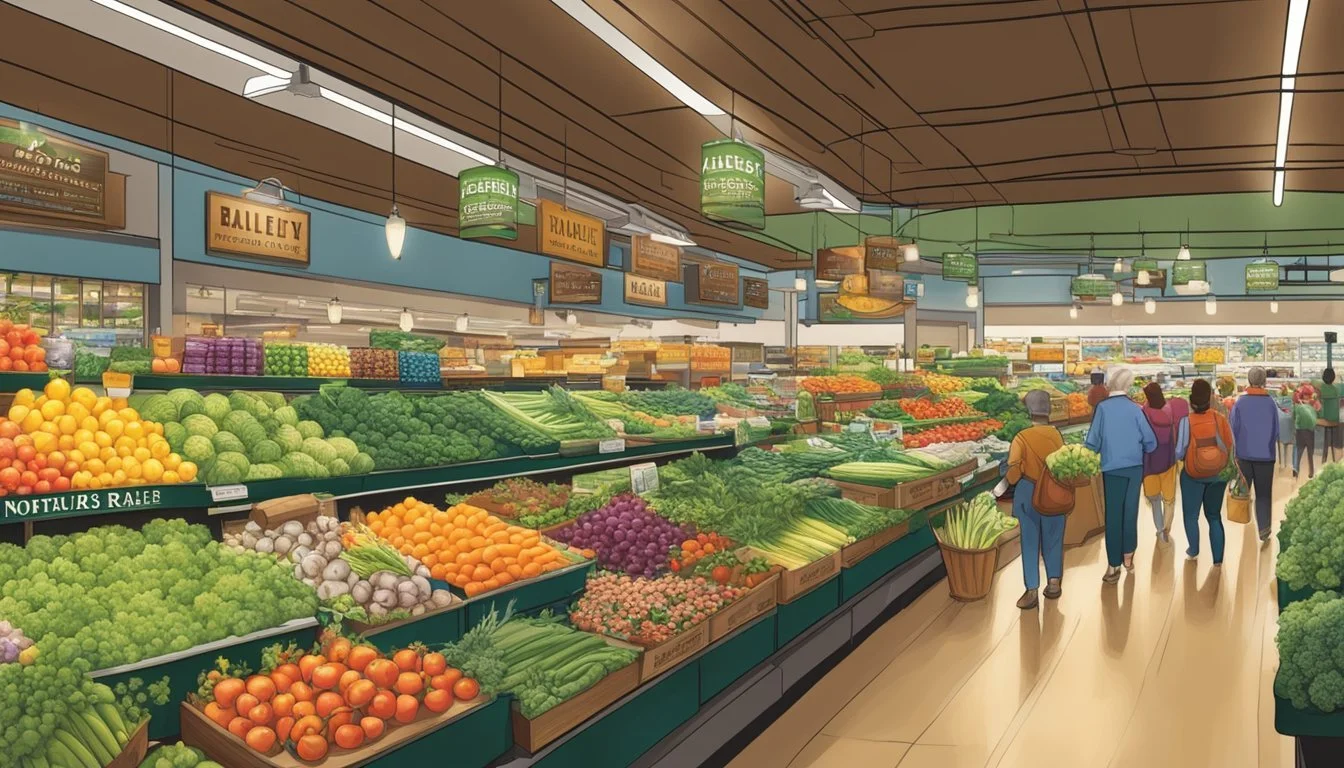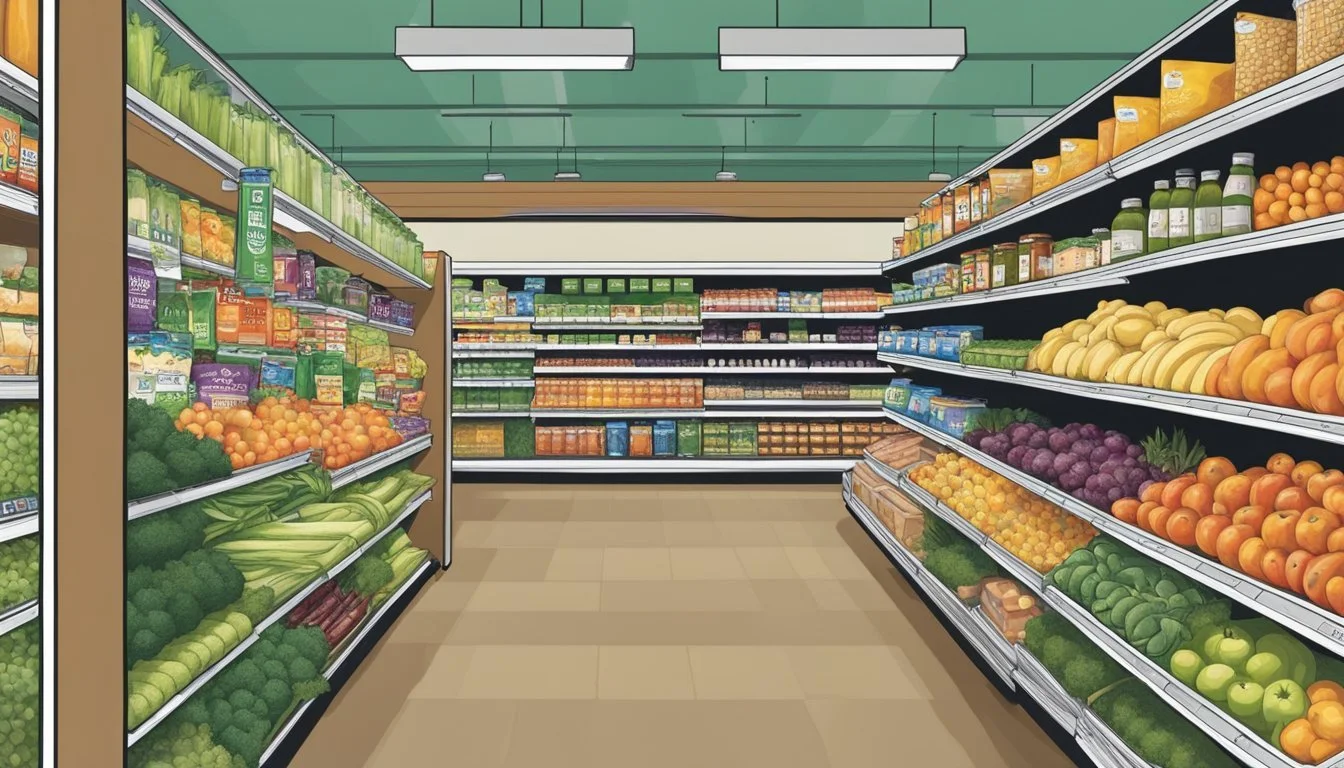Raley's vs Whole Foods
A Comprehensive Comparison of Quality and Value
Grocery shopping experiences can vary significantly between different stores. Raley's and Whole Foods are two popular chains that cater to distinct customer needs and preferences. While both offer quality products, they differ in their focus, pricing, and overall shopping atmosphere.
Raley's tends to provide more affordable prices on everyday groceries compared to Whole Foods, making it a better choice for budget-conscious shoppers. Raley's emphasizes conventional products alongside some organic and natural options. The stores typically have a more traditional supermarket layout and ambiance.
Whole Foods specializes in natural and organic products, with a wide selection of specialty items. It places a strong emphasis on sustainability and ethical sourcing. The stores often feature upscale environments with extensive prepared food sections. This focus on premium products and shopping experience usually comes with higher prices than conventional supermarkets.
Company Profiles
Raley's and Whole Foods represent two distinct approaches to grocery retail. Both companies have unique origins, missions, and strategies that shape their market positions and customer experiences.
Raley's Supermarket Origins and Mission
Raley's Supermarkets was founded in 1935 by Thomas P. Raley in Placerville, California. The company remains family-owned and operates primarily in Northern California and Nevada. Raley's mission focuses on providing quality products and personalized service to its customers.
The company has expanded its brand portfolio to include Bel Air, Nob Hill Foods, and Raley's O-N-E Market. In 2021, Raley's acquired Bashas' Family of Stores, extending its reach into Arizona. Raley's emphasizes community involvement and health-conscious offerings.
Raley's O-N-E Market concept, launched in recent years, mirrors aspects of Whole Foods' approach. These stores feature locally sourced produce, meats, and health-food items, aiming to create a more upscale shopping experience.
Whole Foods Market Evolution and Objectives
Whole Foods Market was founded in 1980 in Austin, Texas. The company quickly became known for its focus on natural and organic products. Whole Foods' mission centers on providing high-quality, minimally processed foods while promoting environmental stewardship.
In 2017, Amazon acquired Whole Foods, leading to significant changes in the company's operations and market strategy. This acquisition enhanced Whole Foods' digital presence and delivery capabilities.
Whole Foods maintains a strong emphasis on quality and organic produce, which has cultivated a loyal customer base. The company operates hundreds of stores across the United States, Canada, and the United Kingdom. Whole Foods' product standards prohibit artificial preservatives, colors, flavors, sweeteners, and hydrogenated fats.
Product Range and Quality
Raley's and Whole Foods both offer extensive selections of fresh, high-quality products. Their offerings cater to health-conscious consumers seeking organic, natural, and specialty items. Each store has its own strengths in certain product categories.
Fresh Produce Selection
Raley's provides a wide array of fresh fruits and vegetables, with an emphasis on locally sourced options when available. Their produce department features seasonal items and regional specialties. Whole Foods is known for its extensive organic produce selection, offering a diverse range of conventional and organic fruits and vegetables. Both stores maintain high standards for freshness and quality in their produce departments.
Raley's often highlights California-grown produce, supporting local farmers. Whole Foods sources globally, providing exotic and hard-to-find fruits and vegetables alongside domestic options.
Meat and Poultry Standards
Whole Foods has stringent standards for its meat and poultry products. They offer antibiotic-free, hormone-free, and organic options. Their butchers can provide custom cuts and offer guidance on preparation methods.
Raley's also maintains high standards for its meat department. They offer a selection of natural and organic meats, as well as conventional options. Raley's focuses on providing value while still ensuring quality across their meat offerings.
Both stores prioritize transparency in their meat sourcing and animal welfare practices.
Organic and Specialty Foods
Whole Foods is a leader in organic and specialty food offerings. They stock a vast array of organic products across all departments. Their selection includes hard-to-find ingredients, international foods, and products for special dietary needs.
Raley's has expanded its organic and specialty food options in recent years. They offer a growing selection of organic products and cater to various dietary preferences. Raley's O-N-E concept stores particularly focus on organic, natural, and specialty items.
Both retailers provide gluten-free, vegan, and other allergen-friendly options. Whole Foods typically has a broader range of these specialty products.
Pricing Strategies
Raley's and Whole Foods employ distinct pricing approaches to attract and retain customers. Their strategies encompass regular pricing, discounts, and exclusive member benefits.
Everyday Prices and Discounts
Whole Foods has historically carried a reputation for higher prices, earning the nickname "Whole Paycheck." However, since Amazon's acquisition, the chain has made efforts to lower costs. Whole Foods now offers competitive prices on many organic and natural products.
Raley's positions itself as a mid-range option, with prices generally lower than Whole Foods but higher than discount chains. The company uses dynamic pricing to adjust to market conditions and consumer demand.
Both stores run regular sales and promotions. Whole Foods features weekly deals and "Prime Member Deals" with extra discounts. Raley's offers weekly specials and digital coupons through its app.
Membership Deals and Benefits
Whole Foods leverages Amazon Prime for its membership program. Prime members receive exclusive discounts, an extra 10% off sale items, and free delivery on orders over $35.
Raley's Something Extra program is free to join. Members earn points on purchases, receive personalized deals, and can redeem points for discounts on groceries or gas.
Whole Foods' integration with Amazon Prime gives it an edge in terms of membership perks. However, Raley's no-cost program may appeal to shoppers who prefer a simpler rewards structure without an annual fee.
Store Experience and Services
Raley's and Whole Foods offer distinct shopping environments and services tailored to their target customers. Both prioritize quality and convenience but differ in their approach to store layout, customer support, and prepared food offerings.
Store Layout and Convenience
Raley's stores typically feature a straightforward layout with wide aisles and clear signage. Products are organized logically, making it easy for shoppers to find what they need quickly. The stores often include a pharmacy and floral department.
Whole Foods stores are known for their open, market-style layout. They emphasize natural and organic products with dedicated sections for specialty diets. The stores often feature unique architectural elements and eco-friendly design.
Both chains prioritize convenience with self-checkout options and dedicated parking areas. Raley's tends to have more traditional supermarket amenities, while Whole Foods focuses on creating an immersive shopping experience.
Customer Services and Support
Raley's prides itself on personalized customer service. Staff members are trained to assist shoppers with product recommendations and nutritional information. The stores offer loyalty programs and digital coupons through their mobile app.
Whole Foods emphasizes product knowledge among its staff. Employees are often experts in their departments, providing detailed information about sourcing and preparation. The chain offers a robust customer service desk for returns and inquiries.
Both stores provide online ordering and delivery services. Raley's partners with Instacart, while Whole Foods integrates with Amazon Prime for exclusive member benefits and faster delivery options.
Prepared Foods and Quick Meals
Raley's offers a selection of prepared foods, including a salad bar, hot food bar, and pre-packaged meals. Their delis provide made-to-order sandwiches and rotisserie chickens. Some locations feature in-store cafes with seating areas.
Whole Foods is renowned for its extensive prepared foods section. Stores often include multiple food stations with cuisines ranging from pizza to sushi. Many locations have full-service bars, coffee shops, and spacious dining areas.
Both chains focus on high-quality ingredients in their prepared offerings. Raley's tends to offer more traditional, family-style meals, while Whole Foods emphasizes gourmet and health-conscious options. Whole Foods typically provides a broader range of vegan and specialty diet prepared foods.
Market Presence and Accessibility
Raley's and Whole Foods differ significantly in their market presence and accessibility. These factors play a crucial role in customer convenience and shopping experiences.
Geographical Reach and Store Locations
Raley's operates primarily in Northern California and Nevada, with 124 stores under various banners including Bel Air Markets and Nob Hill Foods. The company focuses its resources on a smaller geographical area, enhancing its community impact.
Whole Foods, owned by Amazon, has a much broader national presence. It operates over 500 stores across the United States, Canada, and the United Kingdom. This wider reach makes Whole Foods more accessible to a larger customer base.
Raley's concentration in specific regions allows for tailored local offerings. Whole Foods' extensive network provides consistency for customers who travel or relocate.
Online Shopping and Delivery Options
Both chains have adapted to changing consumer preferences by offering online shopping and delivery services. Whole Foods leverages Amazon's infrastructure for efficient delivery options.
Customers can order groceries through the Amazon app or website for home delivery or pickup at Whole Foods stores. This integration provides a seamless experience for Amazon Prime members.
Raley's offers its own online ordering system and delivery service. While not as extensive as Whole Foods' Amazon-powered options, Raley's focuses on serving its regional customer base effectively.
Both stores provide mobile apps for convenient ordering. Delivery areas and times may vary based on location and demand.
Consumer Perception and Brand Reputation
Raley's and Whole Foods have distinct reputations in the grocery market. Their brand images, customer loyalty, and ethical practices shape how consumers perceive and choose between them.
Customer Loyalty and Feedback
Whole Foods enjoys strong brand recognition and customer loyalty. Many shoppers appreciate its focus on natural and organic products. Raley's, while less known nationally, has cultivated a loyal regional following in Northern California and Nevada.
Whole Foods customers often praise the store's product quality and variety. They value the emphasis on organic and locally-sourced items. Raley's patrons highlight the chain's community involvement and personalized service.
Both stores receive positive feedback for their prepared food sections. Customers appreciate the range of ready-to-eat options.
Ratings and Consumer Reports Insights
Consumer Reports surveys have ranked both Raley's and Whole Foods favorably. Whole Foods consistently scores high for produce quality and organic offerings. Raley's receives praise for its competitive pricing and store cleanliness.
In recent years, Whole Foods has faced criticism for high prices, earning the nickname "Whole Paycheck." This perception has led some budget-conscious families to seek alternatives.
Raley's scores well in customer satisfaction surveys. Its pharmacy services and rewards program are particularly popular among shoppers.
Ethical Sourcing and Environmental Policies
Whole Foods has built its brand on ethical sourcing and environmental stewardship. The company maintains strict standards for animal welfare and sustainable farming practices. This commitment resonates strongly with eco-conscious consumers.
Raley's has also made strides in sustainability. The chain has implemented energy-efficient store designs and expanded its organic product lines. These efforts have improved its reputation among environmentally aware shoppers.
Both stores have introduced initiatives to reduce plastic waste and promote reusable bags. Whole Foods has been a leader in this area, eliminating single-use plastic bags in many locations.
Customers increasingly factor these ethical and environmental policies into their shopping decisions. Both Raley's and Whole Foods continue to adapt their practices to meet evolving consumer expectations.
Comparison to Competitors
Raley's and Whole Foods face stiff competition from major grocery chains and specialty markets. Both stores must contend with rivals offering lower prices, wider selections, or unique product offerings.
Major Chains and Grocery Alternatives
Walmart leads the pack in pricing, with costs averaging 19% below other stores. This significant savings attracts budget-conscious shoppers away from pricier options like Whole Foods. Kroger, with its extensive network of stores, provides strong competition through competitive pricing and a mix of conventional and organic products.
Aldi has gained traction with its no-frills approach and low prices on staples. Safeway offers a balance of conventional and organic items at mid-range prices. For some shoppers, these alternatives provide better value than Raley's or Whole Foods.
Publix excels in customer service and prepared foods, areas where Whole Foods traditionally shines. This rivalry is especially pronounced in southeastern markets.
Specialty Market Competitors
Trader Joe's poses a unique threat with its curated selection of affordable organic and gourmet items. Its smaller store format and private-label focus resonate with urban shoppers who might otherwise choose Whole Foods.
Sprouts Farmers Market targets health-conscious consumers with competitively priced produce and bulk goods. Their prices average 14% lower than competitors, appealing to cost-aware organic shoppers.
Natural Grocers and The Fresh Market cater to niche health food markets, competing directly with Whole Foods for discerning organic customers. These specialty stores often boast loyal customer bases in their local communities.
Future Trends and Industry Projections
The grocery industry is poised for significant transformation driven by technological innovation and shifting consumer preferences. Market trends indicate a growing focus on sustainability and personalized shopping experiences.
Innovation in Grocery Shopping
Artificial intelligence and automation are reshaping grocery retail. Smart carts with built-in scanners allow customers to skip checkout lines. Personalized digital assistants provide tailored product recommendations based on shopping history and dietary preferences.
Contactless payment methods continue to gain popularity. Some stores are experimenting with fully automated micro-fulfillment centers for faster online order processing. Virtual and augmented reality technologies enable immersive product exploration from home.
Data analytics help grocers optimize inventory and reduce food waste. Blockchain technology improves supply chain transparency, allowing customers to trace product origins easily.
Sustainable Practices and Growth Strategies
Sustainability has become a key focus for grocery chains. Many are implementing eco-friendly packaging, reducing single-use plastics, and sourcing more local and organic products.
Energy-efficient store designs and renewable energy adoption help reduce carbon footprints. Some retailers are exploring vertical farming to provide ultra-fresh produce with minimal transportation.
Grocers are diversifying revenue streams through expanded prepared food offerings and in-store dining experiences. Loyalty programs are evolving to offer more personalized rewards and experiences.
Strategic partnerships with meal kit companies and local restaurants create unique value propositions. Some chains are expanding into health and wellness services, offering in-store clinics and nutrition counseling.
Final Verdict
Raley's and Whole Foods both offer high-quality grocery options, but cater to different consumer priorities. Raley's provides a more budget-friendly shopping experience while maintaining a focus on fresh, local produce and health-conscious choices.
Whole Foods excels in organic and specialty items, with stringent quality standards for their meats and produce. However, this often comes at a premium price point.
For shoppers prioritizing organic and specialty foods, Whole Foods is the superior choice. Their extensive selection and rigorous sourcing standards are unmatched.
Those seeking a balance of quality and affordability will likely prefer Raley's. The chain offers competitive prices on fresh, local items without sacrificing quality.
Ultimately, the better store depends on individual preferences and budget constraints. Both Raley's and Whole Foods have their strengths, appealing to different segments of grocery shoppers.
Consider your priorities - organic selection, price, local sourcing, or specialty items - when deciding between these two respected grocery chains.










